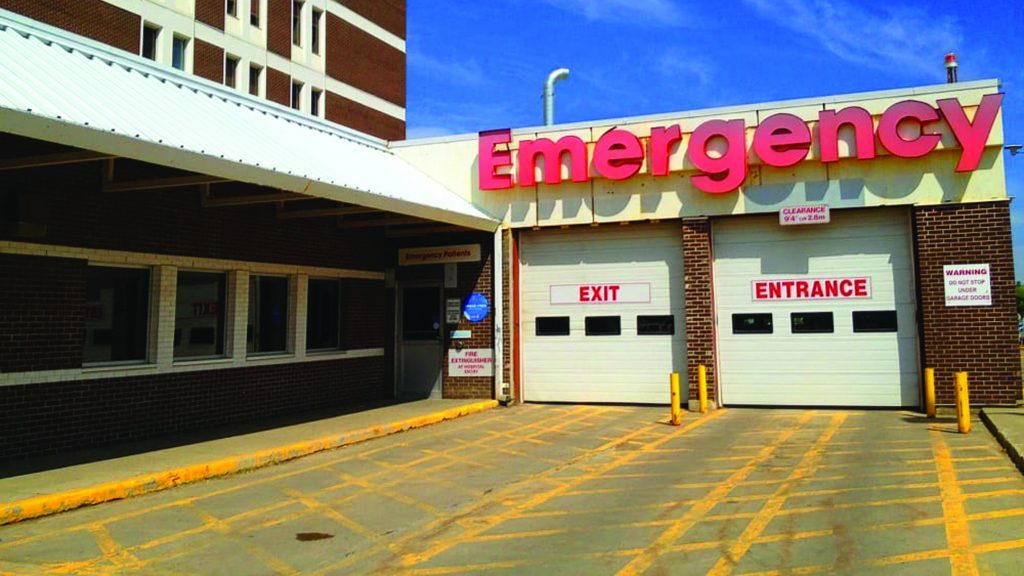Prep work for demolition of a wing at Misericordia Hospital in the west end of Edmonton, Alta., has begun. Crews doing the tear-down and subsequent build of an expanded emergency department, however, must take special precautions as the hospital will continue to operate while work is under way.
In a typical demolition, heavy equipment would be brought on the site to knock down the walls of the acute care facility. In this case, though, “selective demolition” is being used which requires more planning.
The project involves demolition of a chapel, west annex and family medicine centre. When the dismantling begins, precautions will be taken to ensure that activities don’t affect the active hospital. Other measures will also be required to mitigate a steady stream of dump trucks hauling material from the site.
“Once facilities have removed any materials and devices from the buildings to be demolished the first step is to take over as prime contractor, set up perimeter fencing and install signage to establish site boundaries,” explains Greg Nordstrom, superintendent of major projects for PCL which is doing the work.
A number of steps fall into place after that, he notes. The abatement contractor will investigate the building materials in the existing structure to determine if there are any contaminated materials like asbestos. The contractor will submit a plan on any special procedures to be followed, as well as isolate areas with poly hoardings, negative air units and showers to ensure no contaminates leave the workspace.
According to Nordstrom, once the extensive process of abating the buildings is complete, isolation and disconnection of services to the structures to be demolished must be co-ordinated with Alberta Infrastructure (AI), Covenant Health and Facilities Maintenance and Engineering (FM&E) of Alberta Health Services.
A multi-disciplinary team (MDT) consisting of members from PCL, AI, Covenant Health, FM&E, and an infectious control practitioner work together to agree upon a plan established through an Infection Control Risk Assessment (ICRA). The ICRA outlines the risk and controls in order to give all parties peace of mind in reducing or eliminating the risk posed on the active hospital and those doing the work.
“Knowing and understanding the expectations as well as establishing relationships with the MDT makes it relatively easy to plan, get approvals and execute the work,” says Nordstrom. “For all involved, the safety of the hospital staff, patrons, public and the workers executing the work is paramount.”
Hand and power tools and proper personal protective equipment will be used for localized demolition. Scaffolding will be set up. Later, a large backhoe with claw bucket, hydraulic breakers and a skid steer will be needed. Dump trucks will haul material away and water trucks will be brought in for dust control.
Air intakes for the active hospital will also be filtered and maintained during the demolition process and a sound separation wall will be constructed to ensure demolition activities do not impact the active hospital. Meanwhile, emergency exits and pathways will be maintained to ensure no impact to the facility.
“The demolition contractor will utilize various equipment to strategically pull down the existing structure while ensuring dust control measures are in place,” says Nordstrom. “The demolition contractor will separate materials to ensure they end up in the proper landfills or recycling facilities.”
To ensure there is no disruption to the active hospital, including parking lots and vehicular traffic, approved plans and measures will be in place to maintain the safety of the public.
The plan is to use heavy equipment and breakers to remove concrete slabs, sidewalks, grade beams and underground piles to a depth of 1.5 metres. The demolition contractor will also remove any trees and landscaped areas and an excavation crew will strip the area of any organics prior to start of new construction.
Nordstrom said crews will co-ordinate with AI, FM&E and Covenant Health on the extensive underground work in the building and active parking lot areas. Barricades and signage will be set up and traffic re-routed to allow for the concrete and asphalt to be demolished and large excavation, spoil piles and room for large excavators and dump trucks will be required to install the underground services.
The demolition phase of the project is expected to take about four months. PCL is the general on the demolition and build of the new 5,000-square-metre emergency department at the west side of the hospital. All West Demolition is doing the equipment salvage, hazardous materials abatement and demolition. The project is expected to create about 445 jobs during the construction phase.











Recent Comments
comments for this post are closed